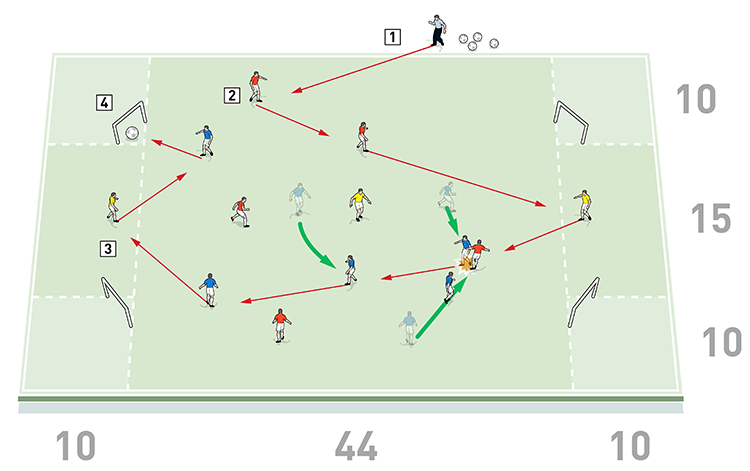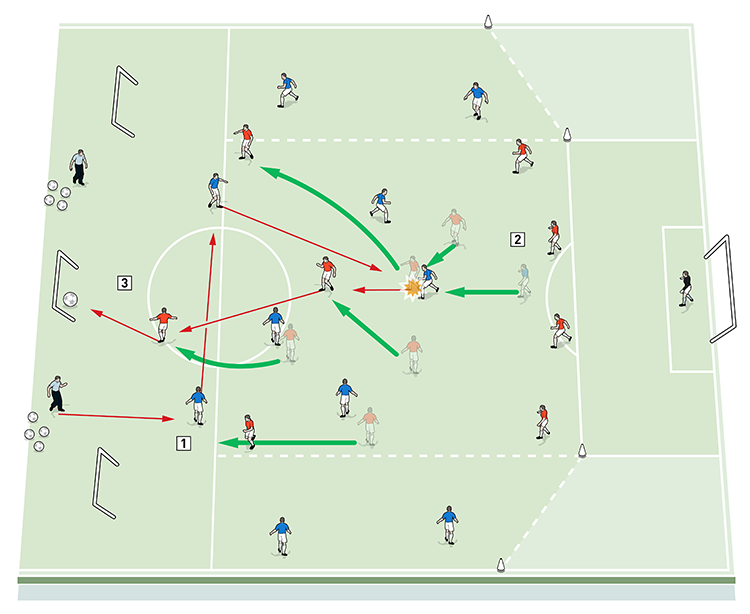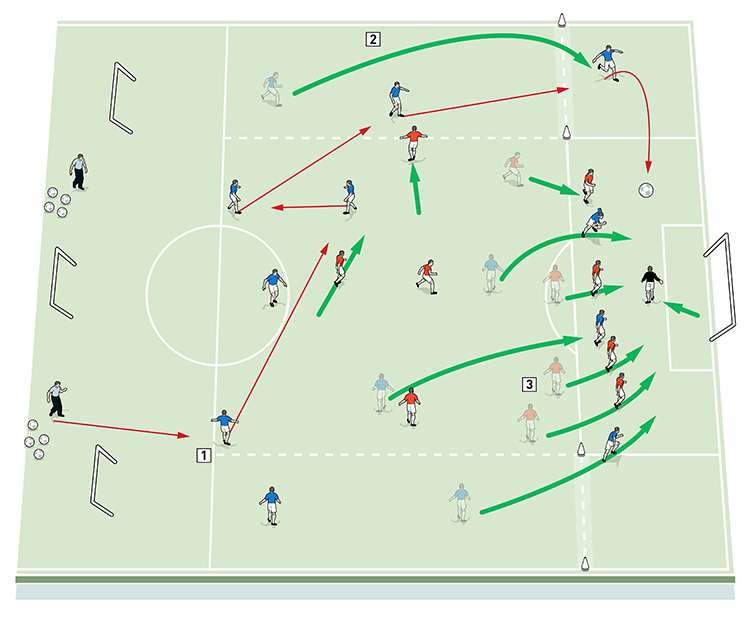Transition to attack from a low block
This session is all about turning defence into attack from the edge of our own box in a controlled and effective manner.

| Area | Up to three quarters of pitch |
| Equipment | Balls, bibs, cones, 4 mini goals, 2 full size goals |
| No. of Players | Up to 20 players + 2 goalkeepers |
| Session Time |
5v5+3: 20mins, 5v5+5: 20mins, Phases of play: 20mins each |
This session is all about turning defence into attack from the edge of our own box in a controlled and effective manner. These activities are part of the build up to a match of huge importance. They are also a big part of a team’s philosophy throughout the season.
Players like to be organised and to know their responsibilities within the team’s structure. When defending the edge of the penalty area in a low block it’s vital that players understand their roles, as any mistakes can be costly and lead to disaster.
I think it’s very important to keep session’s simple, with progressions introduced at the right times to stimulate the minds of the players.
A large part of this session is about the quick transition from defending to attacking and stopping penetration through central areas – this means players have to defend balls arriving from wide areas. It also look at when we have regained possession, focusing on how we react and become progressive up the thirds of the pitch to enable the team to create chances and score.
Players sometimes make strange decisions when put under pressure, so it’s really important to try and recreate a match situation as much as possible. I allow them to make errors and then work on the correct solutions.
These activities should always be a part of a coach’s football philosophy, but there will be times when they will certainly be more beneficial than others. A great example of this is when the team has an away game at a difficult venue against a team who like to play a high pressing game.
TRANSITION FROM DEFENCE: 5v5+3
Having completed the warm-up and a short passing drill [not shown] for a period of 30 minutes, we would then move onto the first practice.
We set up a playing area of 64x35 yards, including a 10x10-yard box containing a mini goal in each corner and a 10-yard end zone at each end. We’re using 13 outfield players divided into two teams of five and three floaters. The two teams play 5v5 in the main area along with one of the floaters, whilst the two remaining floaters are positioned with one in each of the unopposed end zones.
The coach starts play by serving into the one of the teams and they try and keep possession with the help of the floaters. If they make 10 consecutive passes, they score a point. The pressing team must win possession and then complete three passes before they are free to score into the mini goals, as shown [1].
1

2. If the possession team makes 10 consecutive passes, they score a point
3. The three yellow floaters play for the team in possession
4. If the pressing team wins the ball, they must make three passes before they can score in the mini goals. Here the blues score after winning the ball
In each block, teams defends for two minutes at a time and we play four blocks. To increase or decrease the challenge, we can vary the conditions, whether that be allowing the players unlimited touches or limiting them to two touches.
We want to see possession players reacting together to win the ball back on the transition. On winning the ball, players should make sure their first touch is away from pressure. Team mates should support the player in possession by making good angles.
We also want to see players making the correct decisions about whether to protect the ball, dribble with it or pass into the mini goals.
TRANSITION FROM DEFENCE: 5v5+5
We set up a playing area as shown, with a central area of 35x44 yards sandwiched between two penalty areas. The central area is also flanked by two 10-yard wide zones. We position a goal and a goalkeeper at each end.
We’re using 15 outfield players divided into three teams of five. Two teams play 5v5 in the central area and the third team are yellow floaters, who play for the team in possession. Two floaters are positioned in each wide zone, while the remaining floater plays in the central area.
The coach starts by serving the ball into one of the teams in the central area. The possession team has to work the ball from one side to the other using the help of the yellow floaters. Once they have achieved this, the ball can be played into a penalty box at either end for a breakout player to run onto and finish on goal, as shown [2].
2

2. The possession team has to work the ball from one side to the other using the help of the yellow floaters
3. Once the ball has been worked from one side to the other, a pass can be played into the penalty box for a player to run onto and finish
4. If the pressing team wins possession, they must complete three passes before one of them can breakout to receive and finish on goal
5. The player who shoots at goal must recover quickly and help his team win the new ball that will be served to the opposition in the central area
That breakout player must then recover quickly into the central area to join his team in trying to win back a new ball that has been served in by the coach.
If the defending teams wins possession, they must complete three passes before one of their players can breakout into a penalty area and run onto a pass and take a shot at goal.
We want to see quality forward passes made with the correct weight. The breakout player must time his run well and keep composed to finish on goal.
PHASE OF PLAY 1
We set up a playing area on three quarters of a pitch with three small goals at one end and a full size goal and a goalkeeper at the other end. A central area is marked between the penalty area and the halfway line. The flanks are coned off diagonally from the corners of the penalty area.
We’re using 18 outfield players, split into a red team of 8 who defend the full size goal with the help of the goalkeeper, and a blue team of 10 who defend the three mini goals.
The coach starts play by serving to the blue team of 10 and they try to score by penetrating through the central area. The red defending team starts defending from the edge of their own 18-yard box, staying narrow and compact. They should look to force play into the wide areas when possible, preventing penetration through the central area. On transition, their aim is to score into any of the mini goals, as shown [3].
3

2. The red team of 8 starts defending from the edge of their own 18-yard box staying narrow and compact. They should force play into the wide areas when possible
3. On winning the ball the reds should transition quickly to attack and try to score into any of the three mini goals that the blues are defending
We want to see the red team of eight sliding over together and staying in holes to reduce the big gaps between each other and to make it difficult for their opponents to play between the lines.
PHASE OF PLAY 2
We use the same basic set-up as in the previous activity but now we set up gates on either side of the pitch from the outside corners of the 18-yard box to the touch line. We’re using 18 outfield players again, split into a red team of 8 who defend the full size goal with the help of the goalkeeper, and a blue team of 10 who defend the three mini goals.
The red team are still looking at defending the central area to prevent penetration but they now also have to look at defending balls arriving from wide areas. Once the blue attacking team has worked the ball into the wide area, they can pass through the gates and release a team mate to run onto the ball and deliver the cross, as shown [4]. The red defending team must then recover back into position to defend from a cross.
4

2. If the blue team get the ball wide, they can pass through the gate and release a team mate to run onto the ball to cross
3. The reds must then recover back into position to defend the cross
We want to see the red defending players trying to stop the cross and using good, open body positions. If possible we want to see them stepping up and squeezing the play.
PHASE OF PLAY 3
Having dealt with the cross in the previous phase of play, we are now covering the quick transition from defence to attack that starts with the ball being played out from the goalkeeper. Creating space as quickly as possible, the keeper should play the ball out wide. This will enable the team to build up through the units and hopefully finish with a goal scoring opportunity as they transition to attack one of the three mini goals at the other end, as shown [5].
5

2. The keeper should play the ball out wide to create space as quickly as possible
3. The red team builds an attack through the units and they finish by scoring in one of the three mini goals
If it’s not on to play the ball out wide, then the goalkeeper shouldn’t hesitate to go long if needs be. If possession is lost, the team should react like they would in a game.
The coach can restart the attacks at his discretion. This makes the defenders switch on and recover back into a solid shape quickly.
PHASE OF PLAY 4
We use the same basic set-up as in the previous activity but now we use 20 outfield players divided into two teams of 10. The team defending the main goal also has the keeper. We play a normal game but we ask the players to look to counter-attack, as shown [6]. The keeper gives the team attacking the mini goals a numerical advantage, so they should make it count.
6

2. Play always starts and restarts with a pass to the blue team attacking the main goal
3. When they win the ball, the red defending team must transition to attack with a positive attitude, playing the first pass away from the initial pressure
We want to see the counter-attacking team transition from defence to attack with a positive attitude. They should remain patient when defending the edge of their own box and on regaining possession they should stay calm and make a composed decision. After winning the ball they should try to play away from the initial pressure and team mates must find space and give the ball carrier passing options.
Editor's Picks
Attacking transitions
Deep runs in the final third
Using the goalkeeper in build-up play
Intensive boxes drill with goals
Penetrating the final third
Creating and finishing
My philosophy
Pressing initiation
Compact team movement
Coaches' Testimonials

Alan Pardew

Arsène Wenger

Brendan Rodgers

Carlos Carvalhal

José Mourinho

Jürgen Klopp

Pep Guardiola

Roy Hodgson

Sir Alex Ferguson

Steven Gerrard
Coaches' Testimonials

Gerald Kearney, Downtown Las Vegas Soccer Club

Paul Butler, Florida, USA

Rick Shields, Springboro, USA

Tony Green, Pierrefonds Titans, Quebec, Canada
Join the world's leading coaches and managers and discover for yourself one of the best kept secrets in coaching. No other training tool on the planet is written or read by the calibre of names you’ll find in Elite Soccer.
In a recent survey 92% of subscribers said Elite Soccer makes them more confident, 89% said it makes them a more effective coach and 91% said it makes them more inspired.
Get Monthly Inspiration
All the latest techniques and approaches
Since 2010 Elite Soccer has given subscribers exclusive insight into the training ground practices of the world’s best coaches. Published in partnership with the League Managers Association we have unparalleled access to the leading lights in the English leagues, as well as a host of international managers.
Elite Soccer exclusively features sessions written by the coaches themselves. There are no observed sessions and no sessions “in the style of”, just first-hand advice delivered direct to you from the coach.









